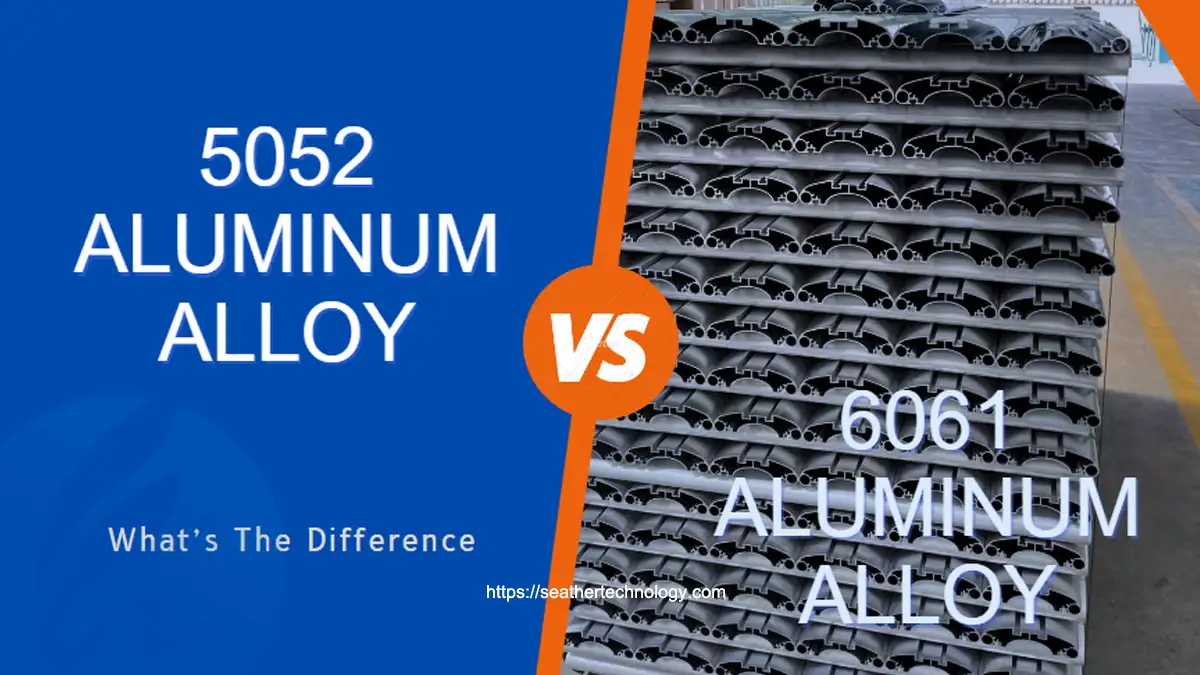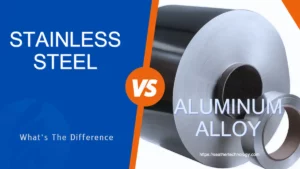Aluminum is a very versatile material and is mostly used as a base metal for many alloys due to its exceptional corrosion resistance, formability, and excellent tensile strength.
The two most widely used aluminum alloys are 5052 and 6061. These alloys are also known as magnesium and magnesium silicon aluminum alloys.
There are several types of aluminum alloys. Every alloy has different properties and applications due to its different compositions.
Generally, a four-digit code (5052 or 6061) is used to identify the aluminum alloy; otherwise, it is difficult to identify a specific alloy for your application.
The first digit of this code shows the main alloying element, the second number indicates the modifications, and the last two digits show the specific alloy in this series.
This article will help you to choose the right aluminum alloy material for your project. Learn more about the difference between 5052 and 6061 aluminum alloy.
What is 5052 Aluminum Alloy?
The 5052 aluminum alloy is one of the most widely used aluminum alloys due to its excellent properties like corrosion resistance, weldability, tensile strength, and lightweight.
The machining of this alloy, like 6061 aluminum alloy, is not easy.
This type of alloy can be strengthened through cold working or work hardening because it is known as a non-heat-treatable alloy and one of the strongest alloys used for many applications.
As a result of these factors, 5052 aluminum performs extremely well as sheet and plate metal, offering great formability and weldability with enhanced strength.
It has a slightly lower density than pure aluminum (2.68 g/cm3) and 2.5%Mg, 0.25%Cr, and 97.25% Al in its chemical composition.
5052 aluminum alloy has no copper content; therefore, it is more resistant to saltwater corrosion than other aluminum alloys, which makes it an excellent choice for marine applications.
What is 6061 Aluminum Alloy?
This grade of aluminum alloy is known for its versatility because it is used in almost every field of life.
6061 aluminum alloy has excellent corrosion resistance properties, good weldability and machinability, and fairly good tensile strength.
Due to these outstanding properties, this alloy is mostly used in construction materials, automotive parts, bicycle and motorcycle parts, and electrical fittings.
The chemical composition of 6061 aluminum alloy includes 0.6% Si, 1.0% Mg, 0.2% Cr, 0.28% Cu, and 97.9% Al.
The density of this alloy is the same as that of pure aluminum (2.7 g/cm3, 0.0975 lb/in3), and the strength of this alloy can be improved by the heat treatment method.
6061 aluminum alloy shows excellent corrosion resistance due to the small amount of chromium.
5052 Vs 6061 Aluminum Chemical Composition
The chemical composition of both aluminum alloys is shown in the given table.
Alloy | Al % | Si % | Fe % | Cu % | Mn % | Mg % | Cr % | Zn % | Ti % | Residuals % |
5052 Alloy | 95.8-97.7 | 0.25 | 0.4 | 0.1 | 0.1 | 2.2-2.8 | 0.15-0.35 | 0.1 | 0 | 0.15 |
6061 Alloy | 95.9-98.6 | 0.4-0.8 | 0.7 | 0.15-0.4 | 0.15 | 0.8-1.2 | 0.04-0.35 | 0.25 | 0.15 | 0.15 |
5052 Vs 6061 Aluminum Specification
Alloy | Thickness mm | Width mm | Length mm |
5052 Alloy | 0.1 to 600 | 20 to 2650 | 500 to 16000 |
6061 Alloy | 0.3 to 500 | 100 to 2800 | 500 to 16000 |
5052 Vs 6061 Aluminum Tempers
5052 aluminum tempers
The aluminum tempers of 5052 includes F, O, H12, H14, H16 , H18, H19, H24, H26, H28, H32 H34, H36, H38, H111, H112, H114.
6061 aluminum tempers
Some common 6061 aluminum tempers are given below:
F, O, T4, T5, T6, T42, T451, T651, T6511, H112
5052 Vs 6061 Aluminum Shape
5052 aluminum shapes
Several shapes of 5052 aluminum alloys are available, which are used in different applications. The products of 5052 aluminum alloy include sheets, plates, embossed plates, 5052 aluminum tubes, 5052 aluminum bars, and extruded profiles.
6061 aluminum shapes
6061 aluminum alloy is available in different shapes, like 6061 aluminum plates, sheets, bars, tubes, and profiles. 6061 aluminum alloys are also available in angular plates and ultra-thick plate shapes, which play a vital role in many applications.
5052 Vs 6061 Aluminum Weight
The density of 5052 aluminum alloy is 2.68 g/cm3 (0.0968 lb/in3), which is slightly lower than that of pure aluminum.
As a result, it can be employed in lightweight applications such as manufacturing aircraft fuel tank materials and electrical appliances.
On the other hand, Aluminum alloy 6061 has a density of 2.7 g/cm3 (0.0975 lb/in3). It weighs almost the same as pure aluminum.
5052 Vs 6061 Aluminum Mechanical Properties
Yield strength
Yield strength is defined as the maximum stress that an aluminum alloy can withstand before plastic deformation occurs. 6061 aluminum has a higher resistance to constant deformation than 5052 aluminum; therefore, its tensile strength is 276 MPa, while the tensile strength of 5052 alloy is 193 MPa). As a result, 6061 alloy has more strength and formability than 5052 aluminum alloy.
Although the yield strength of 5052 aluminum is low, this is beneficial because it requires less effort to reach the plastic (or permanent) deformation area.
Elastic modulus
Elastic modulus is also known as the stiffness of the material. The more elastic material also has a greater modulus, which means it is more difficult to deform such kinds of materials permanently.
The elastic modulus of 5052 aluminum alloy is greater than that of 6061 aluminum alloy. Because of its high elastic modulus and low yield strength, 5052 aluminum can be formed and processed without fear of breakage.
On the other hand, 6061 aluminum alloy has the opposite properties, making it more difficult to deform and less resistant to brittle fracture.
Fatigue strength
The ability of the material to resist the repetition of load cycles is called fatigue strength
6061 aluminum alloy has lower fatigue strength than 5052 aluminum alloy, which indicates that 5052 aluminum will resist more deformation cycles. The 5052 aluminum alloy is more resistant to fatigue damage than the 6061 aluminum alloy.
Machinability
It is the material’s behavior during turning, milling, cutting, drilling, or other processes. Aluminum alloy 6061 has excellent machinability; therefore, it is the best choice for the application in which machining is required.
The elasticity of 5052 is higher, and the chips are excessively large during processing, which leads to excessive mold wear and poor cutting quality. As a result, the machining of 5052 is more challenging than 6061 aluminum alloy.
5052 Vs 6061 Aluminum Alloy Heat Treatment
Heat treatment is one of the common differences between these two. 5052 is known as a non-heat treatable alloy, and it only gets its strength through cold working processes like (cold rolling).
On the other hand, 6061 aluminum alloy got its strength and durability through heat treatment.
It is heated in the furnace at 533 C°, and after heating, this alloy is quenched in water for desired hardness.
5052 Vs 6061 Aluminum Alloy Corrosion Resistance
The 5052 aluminum alloy shows excellent corrosion resistance in saltwater conditions because it has no copper in its composition. Therefore, it is most widely used in marine equipment for natural gas storage tanks.
As a result, 5052 aluminum alloy has better corrosion resistance properties than 6061 alloy.
5052 Vs 6061 Aluminum Alloy Application
Application of 5052 aluminum alloy
5052 aluminum alloy is a very versatile and useful material. It has outstanding corrosion resistance, strength, and formability. Due to these properties, this grade is used in many applications.
Large marine constructions, LNG tanks, and marine equipment are examples of marine applications.
The facade of a building is an example of architectural embellishment.
Electronic shells, kitchen cabinets, electrical appliances, fan and fan blades, household freezers, clock boards, fences, and so on are examples of home appliances.
Transportation includes manufacturing aircraft, buses, and trucks, as well as road and name signs, gasoline pipes and tanks, street lights, and other characters used in the transportation business.
Pressure vessels, sheet metal pieces, heat exchangers, chemical equipment, aluminum pedals, and so on are examples of industrial production.
Application of 6061 aluminum alloy
Structural aluminum is the well-known name of 6061 aluminum alloy. This alloy is available in sheets, plates, tubes, rods, and extruded profiles and is mostly used for making structural parts.
Automobile production:
It includes truck and bus bodies, wheels and different transport terminal applications, brakes, and hydraulic pistons.
Aerospace:
6061 alloy is used in Airplane structural and fuselage components.
Rail transport components:
It includes railway car elements, subway platforms, stairs, floors, coverings, and walkways.
Food sector:
Cans of food and beverages are used in the food sector.
5052 Vs 6061 Aluminum Alloy Price
When we talk about the price comparison between these two alloys, the market rates of alloy 6061 are higher than the 5052 alloy these days because of the high processing cost and the complex manufacturing.
Conclusion
In conclusion, both aluminum alloys play a vital role in their respective applications.
5052 alloy is not a heatreat-able and is very suitable for sheet metal products and has good weldability.
When machining and greater strength are required, 6061 aluminum alloy is the best choice for manufacturers.
Contact us for more information about your aluminum alloys project. Our staff is ready to guide you for further material specifications and requirements.






